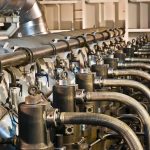In a four stroke engine, exhaust gases flow from each cylinder into the exhaust manifold and then past the turbine blades of the turbo charger. With the engine running at full speed, the turbo charger can obtain speeds up to 100,000 revolutions per minute (rpm). The air compressor blades will revolve at the same speed. Air is drawn through the air cleaner and forced under pressure into the intake manifold. When the inlet valve opens on the induction stroke, with the piston descending in its cylinder, air is forced into the cylinder. It is necessary to reduce the turbo charger speed in stages or slowly for two reasons:
If the engine speed is reduced from full engine speed to stop quickly and the bearings of the turbo charger are lubricated by the main engine driven lubricating oil pump, the engine, on stopping, will cease to supply the lubricating oil to the turbo charger bearings. Because of its high speed, it will take some time for the turbo charger to come to rest and the bearings could be damaged. The exhaust gas side of the turbo charger operates at a very high temperature. It is preferable to reduce the temperature gradually rather than quickly to prevent unequal contraction of the turbo charger parts as it slows down.
Monitoring the performance
Normally, as part of the purchase of a new engine, the engine distributor or dealer will do an installation and pre-run check. The following will be recorded: The speed of the turbo charger at a nominated engine speed.
Air flow in.
Air flow out.
Air pressure after the compressor blades.
Exhaust gas flow
The flow of air going into the turbo charger is important. The air is taken from the engine room so sufficient ventilation to the engine room is required to ensure there is enough for the engine as well as cooling the engine room. The exhaust gas flow is also important. It ensures the installation of the exhaust piping is within limits and not restricting the performance of the engine. As the above is recorded, checks can always be carried out and readings compared with the initial ones.
After coolers (charge air coolers)
An after cooler is also called an inter cooler or a charge air cooler. An after cooler is fitted where an engine is turbo charged, however it is not necessary to fit one. Therefore an engine can be turbo charged or can be turbo charged and after cooled.
The reduction in air temperature will increase the density of the inlet air resulting in more air entering the cylinder. More fuel can then be injected and burnt, giving increased power.
The after cooler is fitted between the air compressor side of the turbo charger and the air intake manifold on the engine. In the after cooler, air passes over the outside of the tubes while the engine cooling water or sea water passes through the tubes usually in the opposite direction (contra flow). Fin plates are attached to the outside of the tubes to increase the surface area for the air, thereby giving a better transfer of heat.
Maintenance
Sea water flowing through the tubes will tend to leave deposits in less time that if fresh water was used. The end covers can be removed and a wire brush pushed and pulled through the tubes. If the scale is not removed by the brush, the tube nest will have to be chemically cleaned.
On the air side, usually no maintenance is required if the air cleaner is doing its job and the filter is changed regularly. A leaking tube will cause the cooling water to pass into the air side. Depending on the design, the air may enter at the bottom and leave at the top to prevent water carrying over with the air. A drain cock is fitted at the bottom.
As the air passes through the after cooler, its temperature may be reduced until it is below the saturation temperature. Heavy condensation of water vapour may then follow, this water being carried into the engine. If this is a problem, a water separator can be mounted between the after cooler and the air inlet manifold.


